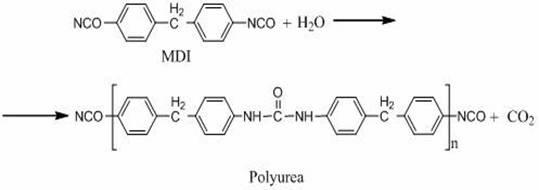Method for preparing microcapsule coated ammonium polyphosphate
A technology of coating ammonium polyphosphate and microcapsules, which is applied in the field of materials, can solve the problems of emigration, unsustainable flame retardancy, and poor compatibility
- Summary
- Abstract
- Description
- Claims
- Application Information
AI Technical Summary
Problems solved by technology
Method used
Image
Examples
Embodiment 1
[0026] Example 1: Preparation of aqueous MCAPP
[0027] First use H 2 O Pre-soak APP to provide conditions for the aggregation of Sipan 80 / 85 on the APP surface.
[0028] In Example 1, the following three mixtures are marked as W 11 , W 12 , W 13 :
[0029] W 11 : "APP clay" (10g APP+1g H 2 O).
[0030] W 12 : Span 80 / 85 (Span80:Span85=3:2; 5g) dissolved in toluene (30ml).
[0031] W 13 : MDI (15g) and DBDL (0.78g) were dissolved in toluene (15ml).
[0032] Mix the organic phase W with a constant temperature magnetic stirrer 12 with W containing capsule core material 11 Stir at high speed for 30 min at room temperature. After the water-containing APP on the surface is wrapped and dispersed by the mixed dispersant, add the solution W 13 , under the condition of high-speed stirring (2000r / min), the temperature was raised to 63° C. to carry out the polymerization reaction of the mixed dispersant film wrapped on its surface, and the reaction was continued for 4 hou...
Embodiment 2
[0034] Example 2: Preparation of anhydrous MCAPP
[0035] In Example 2, the following 3 mixtures are marked as W 21 , W 22 , W 23 :
[0036] W 21 : APP paste (10g APP).
[0037] W 22 : Span 80 / 85 (Span80:Span85=3:2; 5g) dissolved in toluene (30ml).
[0038] W 23 : MDI (2g) and DBDL (0.1g) were dissolved in toluene (15ml).
[0039] The organic phase W was first mixed with a constant temperature magnetic stirrer. 22 with W containing capsule core material 21 Stir at high speed for 30 min at room temperature. After the APP coated with mixed dispersant on the surface is dispersed in toluene, add the solution W 23 , under the condition of high-speed stirring (2000r / min), the temperature was raised to 63° C., so that the mixed dispersant film wrapped on the APP surface was polymerized, and the reaction was continued for 4 hours. After the reaction, the microcapsule slurry was poured out and washed with toluene and water respectively to remove unreacted MDI and uncoated ...
Embodiment 3
[0041] Example 3: Preparation of MCAPP with acetone as organic solvent
[0042] Same as Example 1, first use H 2 O pre-soaks APP to provide conditions for the aggregation of the mixed dispersant on the APP surface.
[0043] In Example 3, the following three mixtures are marked as W31 , W 32 , W 33 ,:
[0044] W 31 : "APP clay" (10g APP+1g H 2 O).
[0045] W 32 : Span 80 / 85 (Span80:Span85=3:2; 5g) dissolved in acetone (30ml).
[0046] W 33 : MDI (15g) and DBDL (0.78g) were dissolved in acetone (15ml).
[0047] Mix the organic phase W with a constant temperature magnetic stirrer 32 with W containing capsule core material 31 Stir at high speed for 30 min at room temperature. After the water-containing APP on the surface is wrapped and dispersed by the mixed dispersant, add the solution W 33 , under the condition of high-speed stirring (2000r / min), the temperature was raised to 54° C. to carry out the polymerization reaction of the mixed dispersant film wrapped on i...
PUM
 Login to View More
Login to View More Abstract
Description
Claims
Application Information
 Login to View More
Login to View More - R&D
- Intellectual Property
- Life Sciences
- Materials
- Tech Scout
- Unparalleled Data Quality
- Higher Quality Content
- 60% Fewer Hallucinations
Browse by: Latest US Patents, China's latest patents, Technical Efficacy Thesaurus, Application Domain, Technology Topic, Popular Technical Reports.
© 2025 PatSnap. All rights reserved.Legal|Privacy policy|Modern Slavery Act Transparency Statement|Sitemap|About US| Contact US: help@patsnap.com


